WORLD CLASS COACHING
Club Curriculum Fun Training Games
By Tony Englund
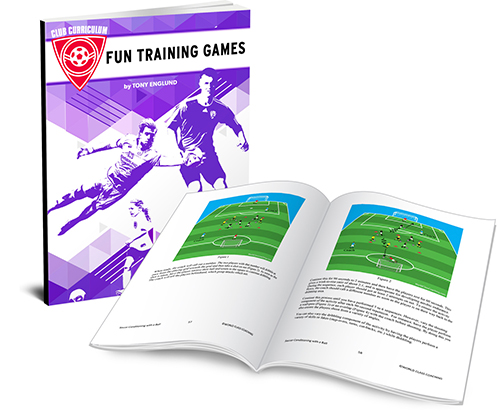
TABLE OF CONTENTS
Part One
INTRODUCTION
DRIBBLING GAMES
Part Two
DRIBBLING GAMES
Part Three
PASSING & BALL STRIKING GAMES
Part Four
PASSING & BALL STRIKING GAMES
ABOUT THE AUTHOR
Introduction: Coaching young children
The starting point for any adult planning to mentor young children is to be certain to adopt the proper perspective in developing a philosophy of coaching that reflects a thorough understanding of the differences between adults and children. Simply put, coaching 6-8 year olds has very little to do with competition and much more to do with introducing young people to physical activity, social interaction in the team setting and having fun playing the game of soccer.
Adults must take into account the physical and psychological abilities and needs of young children in planning and also coaching activities for 6-8 year olds. Children at these ages have immature and growing skeletal and cardiovascular systems that influence their motor abilities. They have limited agility and often go very hard, become exhausted and stop, and then quickly recover. Psychologically, young children have a fragile and evolving self concept that needs consistent nurturing through social acceptance and adult approval of their efforts (as opposed to results), and though they are intrinsically motivated, they do not have the sense of competition that is present in older children and adults.
In addition to accounting for the physical and psychological needs of young children, coaches must also attempt to understand why children play soccer (or any sport), and try to design the team experience to nurture those motivations. Fun, exercise, being with their friends and skill development are all important considerations for young children in this sense. There are numerous studies in print outlining the reasons why children quit playing sports (as many as 75% by age 13). Not surprisingly, those reasons mirror the motivational elements that draw children to participate, as not having fun or improving and not being with their friends are among the chief reasons kids stop playing.
The message, then, is a simple, but very important one: Young children have different physical and psychological needs and abilities than adults and the latter must coach to the needs of the former, not to the needs of a fully mature adult. Children generally play sports for exercise, fun and skill acquisition, not to win, and, as a mentor once explained to the author, “Coaches at this age should judge their success this year not based on wins and losses, but rather on the number of kids who sign up to play again next year.”
Organizing a practice session
One of the most important aspects of coaching is preparation. Even at the youngest ages, players and parents will recognize whether a coach has taken the time to organize his or her thoughts and create an effective, coherent practice plan.
Preparation elements:
• Practice plan: Which exercises will be used and for how much time? What are the key teaching points? The coach should have a written plan for every session.
• Equipment: What types and how many balls, vests, cones, goals, etc. will be needed? Don’t forget a ball pump!
• Safety: The coach should walk the practice area before each session, checking for items that could pose a danger to children. In addition, the coach should carry a phone with emergency numbers for all players. The coach or manager should always have a first-aid kit on site. Lastly, the coach should be the first to arrive and the last to leave training, assuring that there is adult supervision of children at play and that no child is left alone at the field. It is recommended that two adults be present at all times.
U6/U8 Practice
Children at these ages are in the midst of acquiring motor and mental skills, and their U6/U8 experience is often their introduction to the game of soccer. Training for coaches in these age groups consistently emphasizes that the primary goal is for children to have fun and to play games that familiarize them with the basic skills and rules of the game.
Training time
Roughly equal to the length of a game, and generally not more than an hour.
Composition: About ½ (usually the final portion of practice) of every training session should be spent just letting children play soccer. The remainder of the time should be built around a variety of dribbling and ball-striking games. It is recommended that the coach select a couple activities from both part 1 and part 2 of this book. It is important to remember that at this age, children are ready to change activities fairly quickly and it is important to give them new tasks and challenges every few minutes to keep practice fun and exciting.
Sample Training Session
Theme: Individual attacking
Equipment: Balls; vests (2 colors); disc cones; tall cones.
Activity #1
Cone chaos - 20x20 yard grid
Scatter tall cones around the grid area, leaving some upright and some tipped over. Each player has a ball. The players dribble around the area and stop their ball to stand up tipped over cones. If a cone is standing, they can use the inside of their foot to tip it over (no kicking – safety first!). This activity is a good warm-up for very young players to mix dribbling with a bit of agility and fun.
Activity#2
FTL (Follow the leader) dribbling - 20x20 yard grid
Players are organized in pairs with one ball for each player. Designate one player as the leader for each pair. The leaders dribble around the area and their partners must follow them and mimic their touches and speed as closely as possible. This is a simple exercise, but one that players tend to enjoy immensely once they are comfortable. It is very important for the coach to give some ideas for the leaders as to what they can do before starting the first period of play.
Some ideas:
• Change speed
• Change direction.
• Change the foot they use to dribble.
• Change the surface (inside or outside) they use to touch the ball.
Activity #3
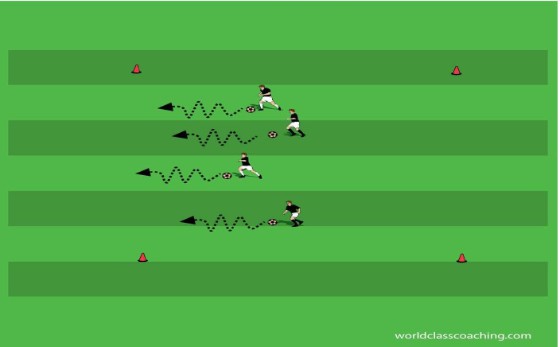
Ice Cream?! - 20x20 yard grid
Each player has a ball. The coach assigns a flavor of ice cream to each of the four lines on the perimeter of the grid. Players dribble around the grid changing speeds and surfaces. The coach calls out a flavor of ice cream and the players must quickly dribble over the appropriate line before returning to the grid.
Activity#4
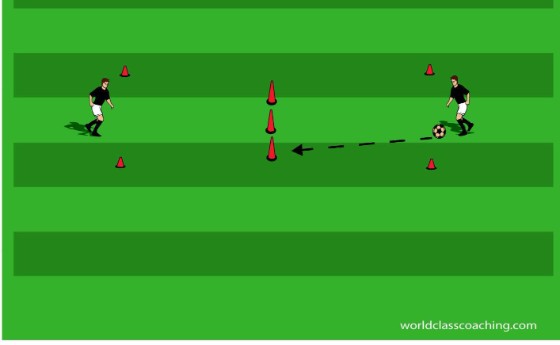
Bowling! - 4x12 yard lanes
Players work in pairs with one ball. Put one player at each end of the lane and give one player the ball to start. Place three tall cones in the middle of the lane. Players take turns passing the ball in an attempt to knock over the cones. When one player has knocked down two cones, she wins that “frame” and the cones are reset to play again. The key points of emphasis are the use of the inside surface (accuracy), locking the ankle of the passing foot, and pointing the toes of the standing foot toward the target cone.
Variations
• The coach should adjust the length of the lane so that players are challenged but also enjoy some success.
• Play for five minutes and then change partners and play again.
• It is also useful to require players to play a frame or more with their “off” foot.
Activity#5
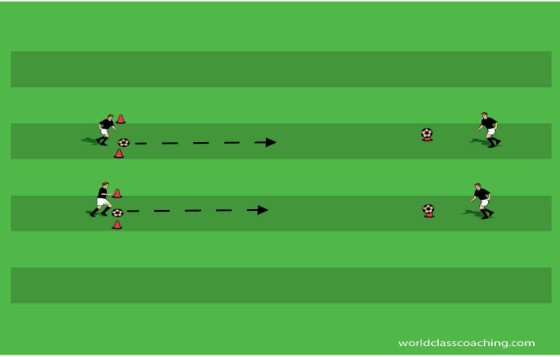
Pineapple Drop - 10x15 yard areas
Divide the group into teams of 3-4. One player puts her ball atop the group’s cone and then steps behind to monitor and retrieve errant shots. The other players form a line and proceed to pass/strike their balls (one at a time) in an effort to knock the ‘pineapple’ off of the cone. When a successful shot is made, the shooter puts her ball atop the cone and becomes the monitor. Play for two minutes and check scores.
Variations
• Players must use their off foot to strike the ball.
• Vary the length of the shot area.
Part 1: Dribbling games!
Coach
• Comfort on the ball. Each of the games in this section will allow players to get many touches on the ball, increasing their comfort level in possession.
• Changes of surface. Players should begin to acquire the ability to use the inside, top, bottom and outside of both of their feet in possession.
• Changes of speed. Players should understand that through changes of speed they can create or exploit space in possession.
• Changes of direction. By suddenly and frequently changing direction, players create more space and new possibilities for attacking.
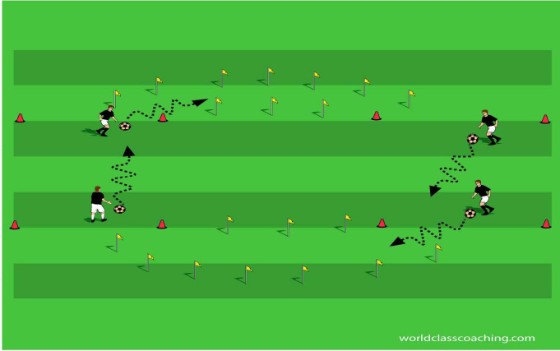
Subway dribbling - 2 12x12 yard grids
Each player has a ball. Players are placed in equal numbers in the two grids. Players dribble around varying speed and surfaces used to dribble. At a signal from the coach, the players dribble out of their grids and through either ‘subway’ to the other grid, where play continues.
Variations
• Use only one foot in the subway.
• Coach uses a visual signal to initiate move to subway.
• Race: Which team can get through the subway and into the other grid first?
• Add a ball thief in the middle of the subway. Anyone who loses their ball gets it back right away and continues.
Red light/green light - 20x20 yard grid
Each player has a ball. Players dribble around the area. The coach gives the following cues: Green: Dribble; Yellow: Speed up! (point out that this does not apply with real traffic lights!); Red: Stop! Play for a minute, compliment-ing good stops and changes of speed.
Coach
Players should focus on keeping the ball close to them and avoiding contact with other players and their soccer balls. Young players will learn to anticipate the need to stop and the use of the sole of their foot for stopping the ball. Also emphasize the importance of dribbling to open space within the grid
Body part dribbling - 20x20 yard grid
Each player has a ball. Players dribble around the area. The coach gives cues as to which body part must be used to stop the ball. This is a fun game designed to build coordination for young players. Suggested cues: Knees; shin; sit on the ball; elbow; ear; nose; back. Emphasize safety first and this is one exercise where the coach might participate to add to everyone’s fun. Play for two minutes.
Body fun dribbling - 20x20 yard grid
Each player has a ball and they dribble around the area, changing speeds and surfaces used to dribble as frequently as possible. When the coach calls out a number, the players must dribble as fast as possible to the perimeter of the grid and then stop their balls. The players then have to touch the ball with as many different body parts as the number called out by the coach.
Zen dribbling - 20x20 yard grid
Players are organized in pairs with one ball for each group. Partners lock arms and one player has the ball and must keep her eyes closed. The other partner provides verbal and physical guidance for the partner in possession. This is a cooperative exercise designed to get players to help each other problem-solve. Play for thirty seconds and then change roles. Play several rounds, being sure to have players change partners frequently so that communication is built across the group. Encourage the instructing player to use specific cues and to give compliments where appropriate. The leading player should work to keep the ball with the dribbling player, in the grid and also away from other pairs and their soccer balls.
Mushroom farm - 20x20 yard grid
Place numerous items (‘mushrooms’ -cones, vests) on the ground inside the grid. Appoint one mushroom farmer (wears a distinctive vest). The mushroom farmer starts in the grid. All other players have a ball and start on the perimeter of the grid. At a signal from the coach, players dribble into the grid and ‘pick’ mushrooms by grabbing items (1 mushroom per trip into the grid) and carrying them out of the grid to their start spot. If the farmer kicks away a player’s ball or tags them, the player must drop any mushroom they are carrying and exit the grid (and recover their ball) before continuing. Play until the grid is empty and then see who picked the most mushrooms. Play again with a different farmer.
Follow the line dribbling - full field
Players dribble along the lines of the field, following the coach. Can they dribble the ball on the line and keep up with the coach?
Progression
• The coach stops the group and explains the meaning of each line to the group. This is a great way to introduce the rules of the game to young players.
• Restrict dribbling to one foot only (alternating inside and outside touches), change speeds and change directions on occasion to keep the exercise fresh for the players.
• Give each of the players a chance to lead the group.
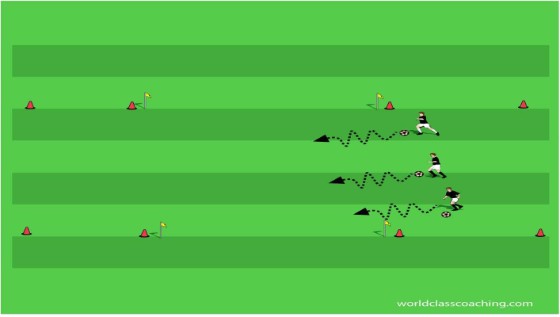
River dribbling - 20x25 yard grid
Each player has a ball. Players begin on one ‘bank.’ At a signal from the coach, players dribble with their ‘fish’ (ball) across the bank, through the river and across the bank on the other side. The coach should indicate any dribbling restrictions (i.e. one foot only; stop and go on command; one touch for each step, etc.).
Variations
• Vary the technique to be performed in the river.
• Pass the ball from the edge of the bank to the river and run onto it before dribbling across the other bank.
• Place ‘rocks’ (cones) in the river. Players must dodge rocks while dribbling.
• Place crabs (seated or standing) in the river who try to win a ball from the dribblers. If they succeed, the two change roles.
Junkyard - 20x20 yard grid
Each player has a ball and they dribble around inside the grid. The coach spreads various items around the area outside of the grid (shoes, clip board, vests, etc.). On the call from the coach, players dribble their ball around a called item and back into the grid. The first player to return to the grid earns a point.
FTL (Follow the leader) dribbling - 20x20 yard grid
Players are organized in pairs with one ball for each player. Designate one player as the leader for each pair. The leaders dribble around the area and their partners must follow them and mimic their touches and speed as closely as possible. This is a simple exercise, but one that players tend to enjoy immensely once they are comfortable. It is very important for the coach to give some ideas for the leaders as to what they can do before starting the first period of play.
Some ideas:
• Change speed
• Change direction.
• Change the foot they use to dribble.
• Change the surface (inside or outside) they use to touch the ball.
There are also fun diversions that can be incorporated, including: Stop the ball with a body part (i.e. left ear); run around the ball and then continue to dribble; fall down and get up and dribble; sing while one dribbles, and the list goes on…The best part of this exercise for the players is that they have control and they tend to be very creative given the chance. Change roles after 30 seconds and play again. Then change partners and play again.
Cone chaos - 20x20 yard grid
Scatter tall cones around the grid area, leaving some upright and some tipped over. Each player has a ball. The players dribble around the area and stop their ball to stand up tipped over cones. If a cone is standing, they can use the inside of their foot to tip it over (no kicking – safety first!). This activity is a good warm-up for very young players to mix dribbling with a bit of agility and fun.

Ice Cream?! - 20x20 yard grid
Each player has a ball. The coach assigns a flavor of ice cream to each of the four lines on the perimeter of the grid. Players dribble around the grid changing speeds and surfaces. The coach calls out a flavor of ice cream and the players must quickly dribble over the appropriate line before returning to the grid.
Variations
• Dribble around corner cones rather than running out over lines.
• Players name each line for some other commodity (favorite dessert, tv show, candy bar, soccer player).
Awareness tag - 20x20 yard grid
Each player has a ball. This tag game challenges players to keep their ball and attempt to tag other players. For the tag to count, it must be applied to the target’s back and before the target calls out the name of the player applying the tag. If the players do not know each other’s names yet, then they can call out the color of the player’s t-shirt or other identifying information. The idea here is to improve dribbling skills while also teaching players to be aware of the space around them. Play for two minutes and then check scores.


